600 years of Brunelleschi's Dome, a story of men and ideas
6 centuries of history and beauty told by the protagonists
A place you think you know everything about: 6 centuries of history - the first stone was laid on 6 August 1420 to be exact - of which the projects, anecdotes, theories and protagonists are well known. Six hundred years of the Dome and Brunelleschi, of a city, Florence, which entrusted its power to a symbol that continues, unchanging, to amaze and intrigue the collective imagination and dominate the city.
The Dome is all of this for us, also on a bright morning last February as we got ready to climb it once again, more to enjoy its timeless impact than to discover something new. But it’s meetings and people that make the difference. Waiting to accompany us was Samuele Caciagli, the architect in charge of the Technical Department of the Opera di Santa Maria del Fiore.
He knows practically everything there is to know about the entire complex from an historical, architectural and monumental point of view. As with anyone who has complete mastery of their subject, however, it is the unsaid, the sounds and vibrations hidden behind the story that excite him the most. It is this that he transmits to us. After a few remarks, for a moment we lose sight of the Dome in all its majesty, and our attention turns to the people who carried out the enterprise. First and foremost, of course, Filippo Brunelleschi, who was given the arduous task of moving the architecture away from the angular lines of the Gothic towards the new language of Humanism.
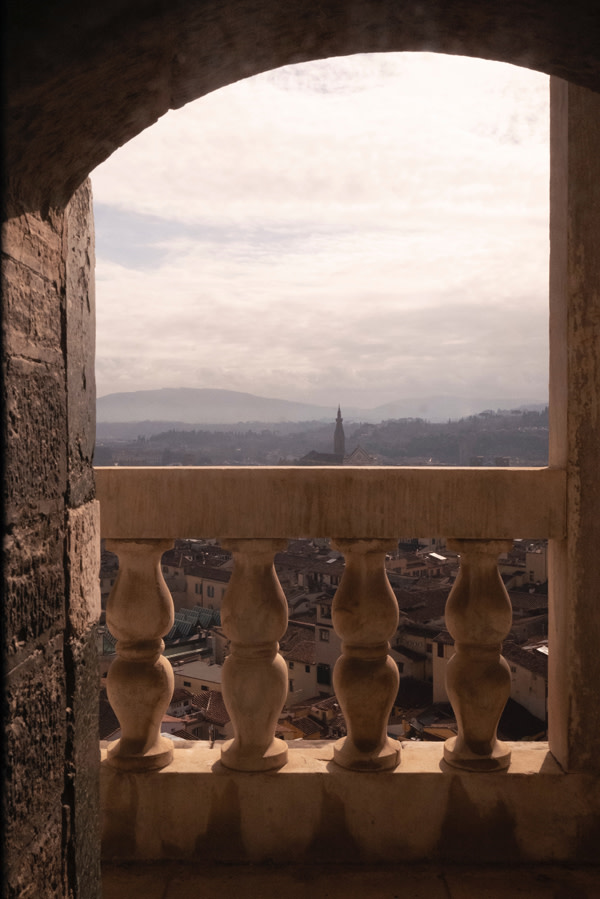 The matter of the Dome was raised around 1418, when a public competition was announced for the coverage of a 43-metre-wide cavity to stand on a drum at a height of 60 metres from the ground
The matter of the Dome was raised around 1418, when a public competition was announced for the coverage of a 43-metre-wide cavity to stand on a drum at a height of 60 metres from the groundMan at the centre; in art and architecture, the Divine merges with the human. From an ethereal, distant figure, Mary became Mother, and it is she to whom Florence dedicated its new cathedral. It was a project that at one time or another involved Arnolfo di Cambio, Andrea Pisano, and Giotto for the first part of the Campanile, and Francesco Talenti, among the most important. Last but not least, Filippo for the coverage of this enormous organism – and it is not a matter of a metaphor, because in the many stages and changes of hand during its construction, Santa Maria del Fiore seems to have always found its balance, until it came to a climax precisely with the Dome. A living being, which breathes through its imposing, round cover.
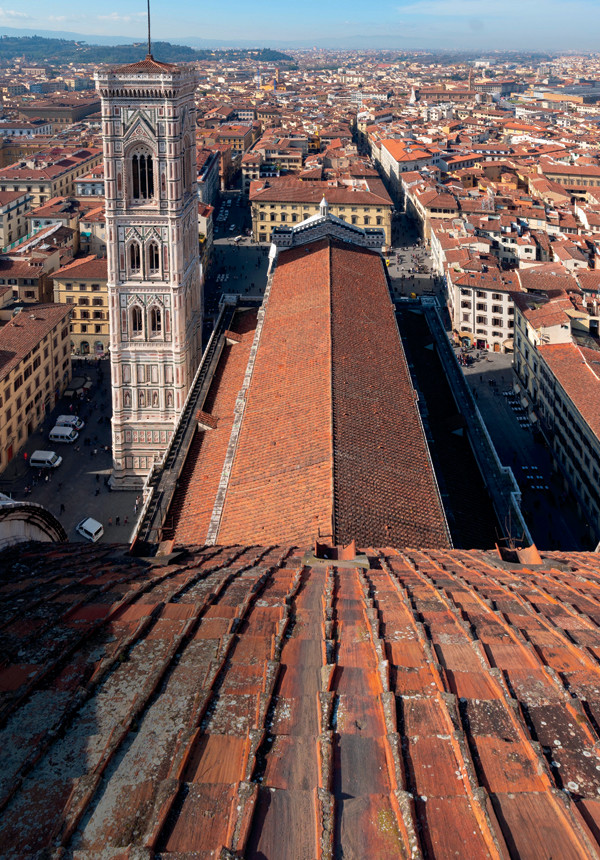 The Campanile and the body of the Cathedral seen from the Dome, projects which involved Arnolfo di Cambio, Andrea Pisano, Giotto for the first part of the Campanile, Francesco Talenti and others
The Campanile and the body of the Cathedral seen from the Dome, projects which involved Arnolfo di Cambio, Andrea Pisano, Giotto for the first part of the Campanile, Francesco Talenti and othersThe matter of the Dome was raised around 1418, when a public competition was announced for the coverage of a 43-metre-wide cavity to stand on a drum at a height of 60 metres from the ground, a solution for which no-one had come up with until then, although it had been hotly debated throughout the second half of the 14th century. There was no official winner of the competition, and the conspicuous prize on offer was not awarded. However, it brought to the fore two up and coming artists, Filippo Brunelleschi and Lorenzo Ghiberti, who had already clashed over decoration of the North Door of the Baptistery in 1401. In August 1420, after having convinced the Grand Council of the Opera with his design, Filippo Brunelleschi began construction of the Dome of Santa Maria del Fiore, the biggest and most urgent building site of that time, and one which would keep him occupied until his death.
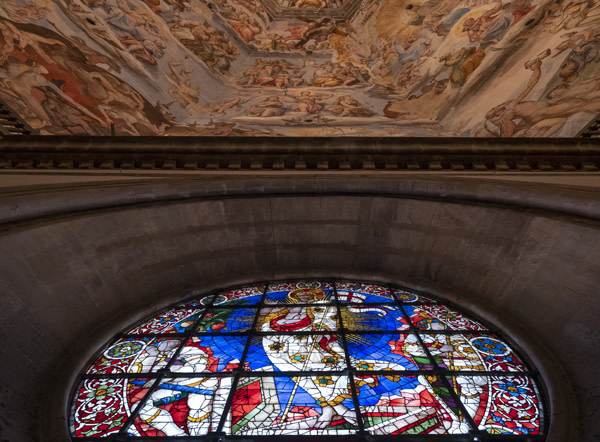 One of the cathedral’s recently restored windows
One of the cathedral’s recently restored windows Engineer, sculptor, mathematician, goldsmith and also scenographer, until the works began, Filippo had only two works to his name as architect – the Old Sacristy of San Lorenzo, perhaps the only work entirely carried out by Brunelleschi, and the Ospedale degli Innocenti, a prime example of the new architecture of humanism.
These were the works that preceded his greatest enterprise – the Impossible Dome. “Large bricks will be made [...] which will be laid together with those in a herringbone pattern by those carrying out the work...”: it was only in 1425 that the forty-eight-year-old Florentine architect thus explained his innovative technique inspired by classical art. Not because he was jealous of his project, as sources have often claimed, but because at the beginning, he himself had just a brilliant idea that he adapted and varied according to the different problems that he faced during completion of the project.
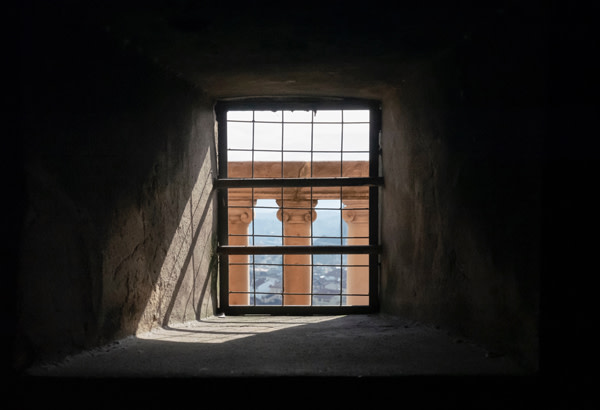 a window during the climb up to the Dome, which acts as a lung for the entire complex
a window during the climb up to the Dome, which acts as a lung for the entire complexThe Dome comprises eight sails arranged in two shells connected by 24 longitudinal and 10 parallel ribs, a refined structural system that holds the two shells together, leaving a space containing the route to access and climb the dome.
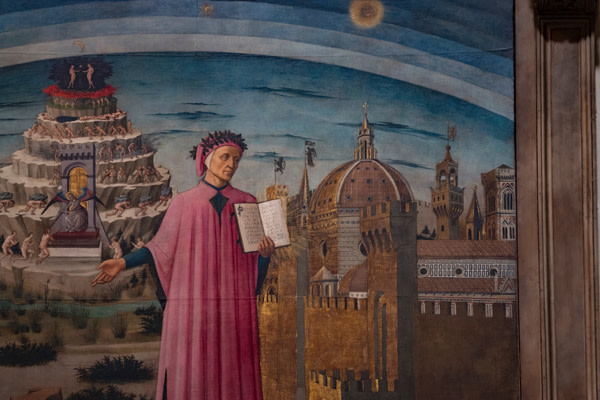 The Divine Comedy Illuminating Florence is a fresco by Domenico di Michelino in the Florence Cathedral
The Divine Comedy Illuminating Florence is a fresco by Domenico di Michelino in the Florence CathedralThis impressive, monumental structure was already completed by August 1436. A truly impossible enterprise that Brunelleschi put his whole self into, as an architect but above all as a man who with his works and his efforts was able to traverse Florence’s golden era without becoming overwhelmed by civil and artistic tensions, and especially by the personal and professional bitterness he had to put up with until the very end of the work to build his Dome. An extraordinary man, who put his trust in God, in his instinct and in the men of his building site, from whom he learned much and who he protected during such an exceptional enterprise - in 16 years of work many metres above ground, there was only one death.
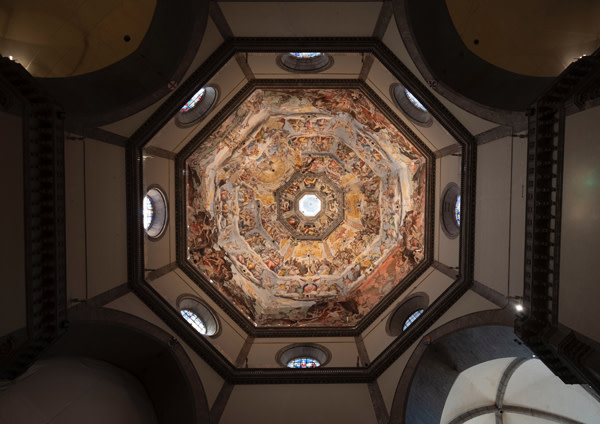 The pictorial cycle on the inside of the Dome is the work of Giorgio Vasari and Federico Zuccari
The pictorial cycle on the inside of the Dome is the work of Giorgio Vasari and Federico Zuccari“… he was given to us from heaven to give new form to architecture” said Vasari in his Le Vite.
Florence and the Opera will be celebrating the Dome from April. Opening the celebrations will be La Cupola Armonica concert on 16 April (9.15pm) in the Florence Cathedral, with the first ever performance of Sognatore di cupole for chorus, treble voices and orchestra commissioned by the Opera di Santa Maria del Fiore and composed for the occasion by Salvatore Sciarrino. Among the other events in a full calendar that you can find on the Opera site (operaduomo.firenze.it), one that should be missed takes place in September 2020. For the first time in history, spectacular night-time 3D projection mapping displays on some of the sails of Brunelleschi’s Dome will recount the most significant aspects of the construction of Florence’s most famous monument. The project, by architects Roberto Corazzi and Samuele Caciagli, is entitled La macchina impossibile. In the meantime, climb the 463 steps leading up to the lantern, absorb the rhythm of the Dome’s breath, and imagine this man who knew how to overcome fear and carry out an enterprise that he himself called impossible. It is without doubt an excellent way to celebrate this anniversary.









